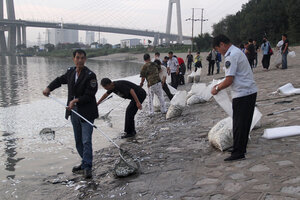Thousands of dead fish appear on Tianjin river week after deadly blasts
The huge die-off of fish was found about four miles from the chemical explosions site in the coastal Chinese port city.

Workers remove dead fish from the Haihe river at Binhai new district in Tianjin, China, on August 20, 2015.
Stringer/Reuters
Reports of thousands of dead fish washing up on a riverbank near the location of a massive chemical explosion in Tianjin, China left residents worried that toxic chemicals from the blast could have contaminated the waters. However, Chinese authorities say there is no link between the two incidents.
On Thursday, photos showing the surface of a river at Tianjin's Binhai district covered in dead fish spread on social media a week after massive explosions rocked the Chinese port city. The blasts left at least 116 people dead, according to CCTV News, the Chinese English-language news channel.
CCTV News reported the fish were found 3.7 miles from the blast site.
Chinese authorities have denied that the deaths of thousands of fish are linked to last week’s chemical explosions in Tianjin, The Guardian reported. Xinhua, China’s official news agency, says no toxic levels of cyanide had been found in the river during tests on Thursday afternoon.
At a press conference on Thursday Deng Xiaowen, the head of Tianjin’s environment monitoring center, vowed to investigate the fish deaths but said “it was not uncommon for fish to die en masse in local rivers during summer, due to poor water quality." He added that “When the temperature rises, oxygen will evaporate and fish may die of hypoxia.”
Authorities say about 40 types of chemicals were being stored at the warehouse at the center of the explosions, The Guardian reported. The New York Times says that the authorities have acknowledged that at least 700 tons of sodium cyanide were stored at the warehouse.
High levels of dangerous chemicals remain at the site of the blasts, CNN reported Thursday. Officials said at some areas the level of dangerous chemicals is hundreds of times higher than safety limits allow.
Ministry of Environmental Protection official Tian Weiyong said Thursday that water tests show high levels of sodium cyanide, a highly toxic chemical, at eight locations near the blast site.
But he added that the polluted water is in a "warning zone" around the blast site. "Cyanide pollution is severe inside the warning zone. Outside the zone overall, the amount of cyanide detected is at normal range," Mr. Tian said.
Tianjin’s environmental chief Wen Wurui says spilled chemicals would not “significantly influence human health.”
Currently, the cleanup is ongoing at the site of last week's explosions. It’s not clear how long it will last.
"For safety reasons, the team can't work when it rains and during the night. And there is a great variety of chemicals and the placement is very complicated,” Mr. Wen said in a press conference Wednesday. “We can't say when the cleanup work in the blast center will be finished.”

